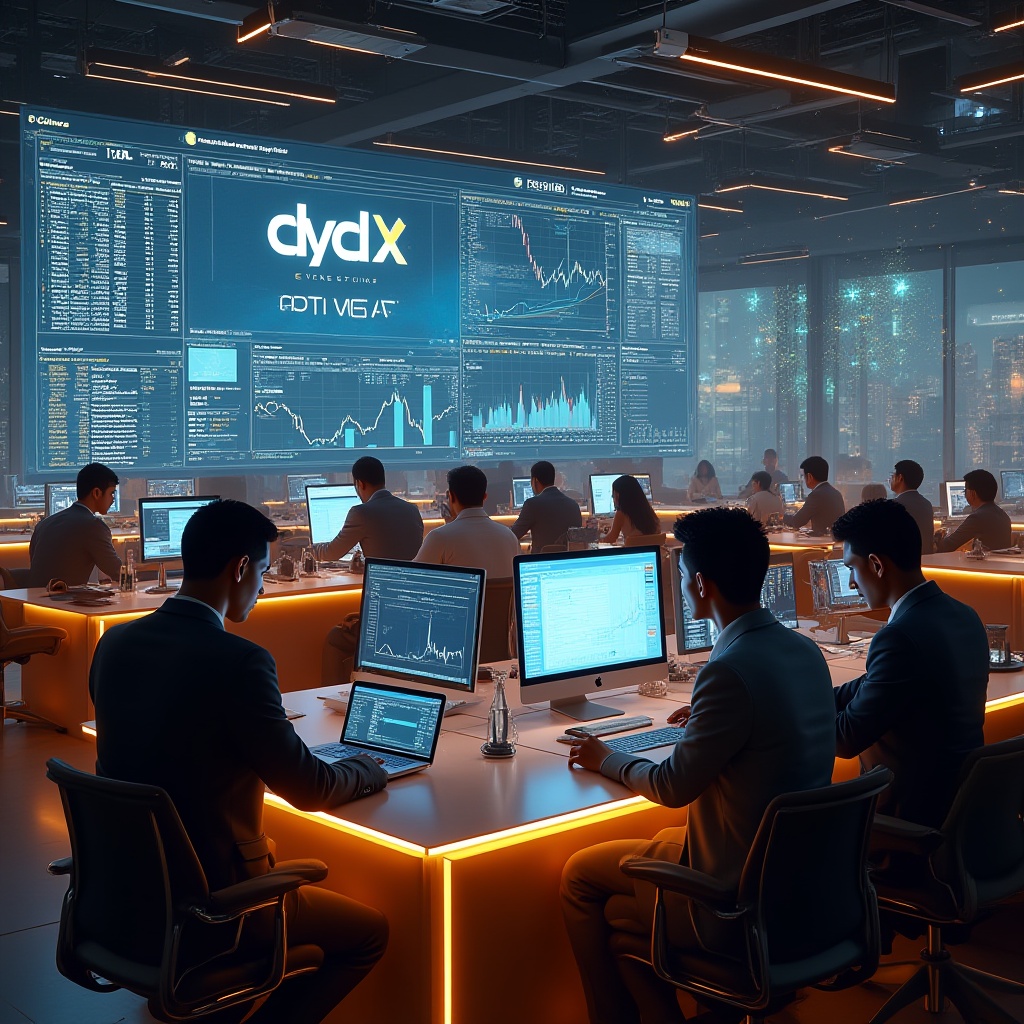In the fast-moving world of decentralized finance (DeFi), innovation often comes in waves that reshape entire ecosystems. One of the boldest moves recently has been dYdX’s transition from a Layer 2 solution on Ethereum to a fully sovereign Layer 1 blockchain, built on Cosmos. This migration is more than just a technical upgrade; it represents a fundamental shift in how decentralized applications might achieve scalability, sovereignty, and community control. The concept of the “app-chain” — an application-specific blockchain — has been debated for years, but dYdX’s journey provides a live case study to assess its potential.
This article dives deeply into the dYdX Chain’s adoption stats, technological merits, ecosystem growth, and whether this app-chain experiment is truly paying off. Whether you’re a DeFi trader, a crypto analyst, a developer, or an institutional investor, this comprehensive review offers a clear picture backed by up-to-date, verifiable data. By the end, you’ll understand why many in the crypto community see dYdX’s move as a potential roadmap for the future of decentralized finance.
Introduction: dYdX’s Bold Leap into Sovereignty
dYdX started as a decentralized derivatives exchange built on Ethereum, relying heavily on Layer 2 scaling solutions like StarkWare to improve throughput and reduce gas fees. While this approach helped the protocol grow its user base and trading volumes, inherent limitations of Layer 2 chains tied to Ethereum’s base layer persisted. These limitations included dependency on Ethereum’s transaction finality, limited governance control, and constraints around customization.
In late 2023, dYdX unveiled a bold new direction: launching its own sovereign Layer 1 chain built using the Cosmos SDK framework. This chain, often referred to as the “dYdX Chain,” was designed as an application-specific blockchain, optimized exclusively for decentralized derivatives trading. The vision was clear: build a blockchain tailored precisely to dYdX’s needs, eliminating unnecessary general-purpose overhead and enabling the protocol to control all aspects of its operation, from consensus to tokenomics.
This shift encapsulated the broader concept of app-chains — blockchains dedicated to specific applications rather than general-purpose smart contract platforms. The promise of app-chains is high throughput, ultra-low latency, and sovereignty over governance and economics, potentially unlocking new levels of innovation and user experience. But with great promises come critical questions. Would the dYdX Chain attract users? Would it sustain high trading volumes? Would the app-chain model prove scalable and secure? These questions underpin this article’s exploration.
Adoption Milestones: By the Numbers
Trading Volume & User Growth
The most tangible sign of any exchange or blockchain’s health is trading volume. Since launching its app-chain in October 2023, dYdX has demonstrated staggering volume figures that validate the ambition behind its move. Year-to-date in 2025, the dYdX Chain has facilitated over $330 billion in cumulative trading volume, consistently averaging around $500 million daily. These numbers place it squarely among the largest decentralized derivatives platforms globally.
Delving deeper, as of early 2025, the protocol reports processing over $232 billion in volume specifically on the dYdX Chain itself. This surge is notable considering the chain’s relative youth and the competitive DeFi landscape. Such volume has translated into substantial rewards for ecosystem participants: more than $39 million in USDC has been distributed to validators and stakers, demonstrating active community participation and token utility.
User adoption echoes this growth story. Daily active users (DAUs) on the dYdX Chain consistently exceed 30,000, a remarkable figure that underscores the chain’s appeal to traders. These users benefit from fast transactions, low fees, and seamless order execution, contributing to vibrant liquidity and market depth. This level of engagement rivals or surpasses many established decentralized exchanges (DEXs) and Layer 2 trading platforms, signaling that dYdX’s migration has not just retained its user base but grown it meaningfully.
To put these numbers into perspective, many decentralized exchanges on Ethereum Layer 2 networks struggle to maintain even a fraction of this user activity and volume. dYdX’s ability to pull such numbers in a highly competitive environment highlights the strategic advantage of its app-chain architecture and the trust the community places in it. It also marks a milestone in DeFi’s evolution, showing that specialized chains can thrive with the right design and incentives.
Token Migration & Ecosystem Integration
Alongside volume and user stats, token migration offers a lens into ecosystem commitment. Since the launch of the dYdX Chain, a substantial majority of DYDX tokens—around 86%—have migrated from Ethereum Layer 1 to the dYdX Chain. This migration reflects a consolidating ecosystem and growing community trust in the new chain’s governance and utility.
The migration effort is no small feat. It requires coordination among token holders, developers, and infrastructure providers to ensure smooth bridging and minimize disruption. The strong uptake signals user confidence in the chain’s stability and long-term prospects. Moreover, it encourages dYdX to consolidate liquidity and governance on its native platform, simplifying ecosystem dynamics.
Importantly, the dYdX community has indicated a clear intention to phase out Ethereum-based DYDX bridges, proposing to end support by June 2025. This move encourages token holders and users to fully embrace the app-chain environment, signaling confidence in the chain’s maturity and security. Such decisions have the potential to streamline ecosystem activity, reduce fragmentation, and bolster token value.
This decisive step towards ecosystem unification is significant. It sends a message that dYdX views its sovereignty not just as a technical novelty but as a central pillar for its future growth. By concentrating token activity and governance on its own chain, dYdX is better positioned to iterate quickly, respond to community needs, and build innovative features that Layer 2 limitations would have otherwise prevented.
App-Chain Architecture: A Performance Powerhouse
Technical Advantages
The technological foundation of the dYdX Chain is a critical factor behind its impressive adoption metrics. Built on the Cosmos SDK, a modular framework designed to simplify the development of application-specific blockchains, dYdX leverages CometBFT (formerly Tendermint) for consensus. This design allows the chain to achieve over 2,000 transactions per second (TPS), a substantial improvement over the throughput limits of many Layer 2 solutions and general-purpose Layer 1s.
By building on Cosmos, dYdX benefits from a robust ecosystem and interoperability standards like the Inter-Blockchain Communication (IBC) protocol. This enables seamless communication with other chains in the Cosmos network, broadening liquidity sources and enabling future composability.
What sets the dYdX Chain apart technically is its architecture combining on-chain settlement with a fully decentralized off-chain order book and matching engine. This hybrid model allows the platform to process orders swiftly with minimal latency while maintaining decentralized custody and settlement guarantees on-chain. The result is a trading experience that closely rivals centralized exchanges in speed and efficiency but retains the security and transparency of blockchain settlement.
Furthermore, this architecture reduces gas consumption drastically. Because the order matching happens off-chain, users don’t need to pay for every single trade execution on the blockchain, lowering costs and increasing accessibility for smaller traders. This contrasts with some other DeFi platforms that require on-chain order book updates for every trade, which can be prohibitively expensive.
The flexibility provided by the app-chain model allows dYdX to introduce custom modules optimized for derivatives trading, margin calculations, and liquidations—features difficult to implement efficiently on generic blockchains. This specialization translates into improved risk management, faster dispute resolution, and better user protection.
Enhanced User Experience
Technical prowess translates directly to user benefits. The dYdX team has rolled out features to harness the app-chain’s capabilities fully. For example, the launch of dYdX Unlimited in November 2024 introduced permissionless market listings, empowering users and projects to create new trading pairs without centralized gatekeeping. This open approach fosters innovation and broadens available markets for traders.
Permissionless market creation marks a major shift from traditional exchanges, which often limit new listings to approved projects. dYdX Unlimited lowers barriers for emerging tokens and derivatives products, enhancing market diversity and attracting niche communities. This democratization of market access aligns with DeFi’s ethos and encourages broader ecosystem participation.
Further, the reimagined mobile trading experience launched in February 2025 has made high-performance DeFi trading accessible on-the-go. Mobile users enjoy intuitive interfaces, near-instant trade execution, and seamless access to liquidity. These improvements have lowered barriers to entry, contributing to the growing daily active user base and expanding community.
Mobile adoption is critical given global shifts toward smartphone-based internet usage. By prioritizing a seamless mobile experience, dYdX is positioning itself to capture new demographic segments, including emerging markets where mobile-first financial services are standard. This focus on usability complements the underlying technical advances and reinforces dYdX’s competitive edge.
Tokenomics & Incentive Structures
Reward Mechanisms
dYdX’s tokenomics underpin its vibrant ecosystem activity. The protocol distributes rewards in multiple ways to encourage trading, staking, and ecosystem participation. Trading rewards are paid in DYDX tokens, incentivizing market makers and active traders. Staking rewards, primarily denominated in USDC, offer more stable yields, attracting validators and long-term supporters.
This dual-token incentive structure balances volatility and stability, helping maintain network security while promoting liquidity and user engagement. Traders receive direct benefits tied to platform performance, while validators enjoy predictable rewards, strengthening chain security.
At launch, a six-month incentive program allocated approximately $20 million in DYDX tokens to boost user engagement and liquidity provision. This program successfully seeded the network with sufficient liquidity, ensuring smooth operations during the critical early phases of the chain’s rollout.
The incentive program was carefully calibrated to attract a broad base of users, from retail traders to institutional participants. It included tiered rewards based on trading volume, staking amount, and referral success, fostering both depth and breadth in the user base. The early success of this program is evident in the robust trading volume and active validator participation seen today.
Buyback Program & Emission Reductions
In March 2025, dYdX announced the first-ever DYDX buyback program aimed at enhancing token value and aligning emissions with platform growth. This buyback initiative uses platform revenue to repurchase DYDX tokens from the market, reducing circulating supply and signaling strong project fundamentals.
Buybacks are a mechanism to return value to token holders and help stabilize prices. By coupling buybacks with decreasing emissions, dYdX aims to create sustainable tokenomics that reward long-term holders while maintaining sufficient incentives for active participation.
Additionally, token emission rates are scheduled to decrease by 50% starting June 2025, following governance approval. With approximately 85% of DYDX tokens unlocked by this time, these reductions balance incentives with scarcity, potentially supporting token price stability while maintaining robust ecosystem rewards.
This emission schedule reflects a maturing protocol transitioning from growth-focused incentives to sustainability. It also empowers the community and governance participants to adapt token economics dynamically in response to market conditions and platform needs.
Ecosystem Development & Institutional Adoption
Infrastructure & Tooling
The dYdX ecosystem has attracted significant developer and institutional interest, reflected in a series of grants and integrations. For instance, grants have been awarded to projects integrating dYdX trading functionalities into platforms such as TradingView, enabling traders to execute orders directly from charts. Similarly, partnerships with custodial service providers like Fireblocks enhance security and ease of access for institutional clients.
Such integrations blur the lines between decentralized and centralized finance, making dYdX accessible to a wider audience. Institutional players, who require robust custody solutions and seamless interfaces, find these developments encouraging. This institutional onboarding expands liquidity, stabilizes trading volumes, and legitimizes dYdX as a professional-grade platform.
Notably, Bitget, a major crypto exchange, integrated dYdX Chain trading, further expanding liquidity sources and bridging centralized and decentralized finance environments. These developments indicate growing confidence from both developers and institutions in dYdX’s architecture and market positioning.
Additionally, dYdX grants program incentivizes developers building complementary infrastructure like analytics dashboards, wallets, and arbitrage tools. This grassroots developer support helps rapidly expand the ecosystem’s capabilities and resilience.
Community Engagement
dYdX’s growth is not purely technical or institutional—it’s deeply community-driven. The protocol regularly hosts trading competitions, which reward participants with tokens and prizes, fueling active market participation. Additionally, the affiliate program launched with dYdX Unlimited encourages users to onboard new traders, fostering organic network growth.
These programs create a dynamic environment where traders are motivated not only by profit but by community belonging and recognition. This social layer enhances retention and user loyalty, critical for long-term protocol success.
Such initiatives help maintain liquidity and trading volume, creating a virtuous cycle that sustains the chain’s adoption and relevance. Community engagement remains a core pillar in dYdX’s strategy to differentiate itself from other DeFi projects.
Comparative Analysis: App-Chain vs. Layer 2 Solutions
Evaluating dYdX’s move requires understanding the differences between app-chains and traditional Layer 2 scaling solutions. Layer 2s like Optimism or Arbitrum rely on Ethereum’s security and consensus but provide enhanced scalability by processing transactions off-chain and settling periodically on Ethereum. This model reduces fees but inherits Ethereum’s throughput limitations and governance constraints.
In contrast, app-chains are sovereign blockchains designed specifically for a single application or protocol. This sovereignty grants full control over protocol upgrades, governance, and tokenomics, enabling optimization impossible on Layer 2. For dYdX, this has meant significantly higher TPS, lower latency, and the ability to design a governance model aligned entirely with the derivatives trading ecosystem.
However, app-chains also bear the responsibility of securing their own network, requiring a robust validator set and security model. The dYdX Chain’s integration into Cosmos’s interoperability protocols (IBC) mitigates some risks by connecting it to a wider ecosystem and enabling cross-chain liquidity and communication.
Early adoption stats suggest that dYdX’s app-chain is outperforming many Layer 2 exchanges in both volume and user engagement, validating the architectural choice. Yet, it remains a pioneering effort, with ongoing challenges related to ecosystem maturity, tooling, and security assurances.
Comparatively, while Layer 2 solutions benefit from Ethereum’s massive security, they often suffer from slower finality times and limited governance flexibility. App-chains like dYdX, in contrast, offer tailored user experiences and protocol sovereignty but must carefully manage decentralization and security to avoid centralization risks.
Conclusion: Is the App-Chain Model Vindicated?
The dYdX Chain’s journey from a Layer 2 project to a full-fledged application-specific blockchain has yielded impressive results. With over $330 billion in trading volume, a growing user base exceeding 30,000 daily active users, and robust tokenomics backed by buybacks and emission reductions, dYdX has proven that the app-chain model can deliver real value and scalability in DeFi.
Technological innovations such as the Cosmos SDK foundation, CometBFT consensus, and off-chain matching engines have combined to offer a trading experience that is fast, cost-efficient, and decentralized. The growing ecosystem, including institutional integrations and community incentives, further bolsters the chain’s viability.
While challenges remain—such as securing a decentralized validator set and competing with entrenched Layer 2 solutions—the data-driven adoption metrics strongly support the app-chain model as a viable path for specialized DeFi protocols. dYdX’s success offers a blueprint for others considering sovereignty and scalability without sacrificing decentralization.
Looking ahead, dYdX’s trajectory will be closely watched as a test case for the future of blockchain application design. If its momentum continues, the app-chain approach could become a dominant paradigm, reshaping how decentralized applications architect themselves in a multi-chain world.





